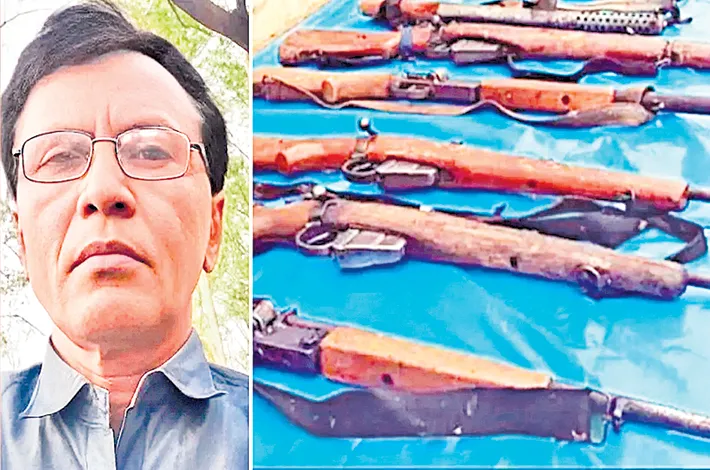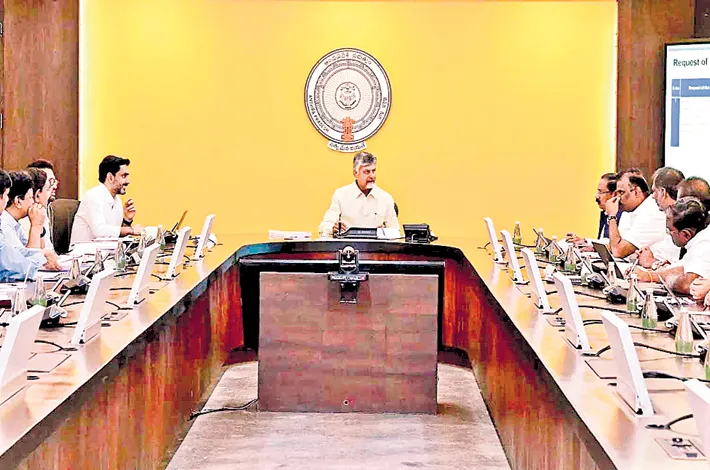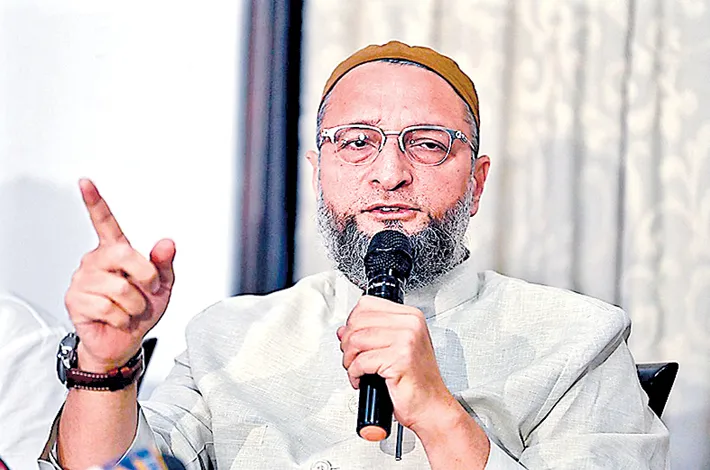Endgame for Red Rebellion?
15-10-2025 12:00:00 AM

Maoist Top Brass Crumbles: Politburo Veteran Sonu Surrenders with 60 Cadres
In a seismic shift that could hasten the twilight of India's four-decade-long Maoist insurgency, Mallojula Venugopal Rao, the enigmatic Politburo member better known by his nom de guerre "Sonu" or "Abhay," laid down his arms today alongside 60 battle-hardened cadres in the dense jungles of Gadhchiroli district. The surrender, witnessed by top Maharashtra Police officials and representatives from the Union Home Ministry, marks not just a personal capitulation but a profound fracture within the Communist Party of India (Maoist), the outlawed outfit that once commanded thousands in its quest for a "people's war" against the Indian state.
At 70 years old, Sonu—frail from decades of evasion and recent health woes—emerged from the shadows of the Abujhmad forests, his once-imposing frame a stark reminder of the Maoist movement's inexorable decline. Flanked by his surrendering comrades, many from the Dandakaranya Special Zonal Committee (DKSZC), Sonu addressed a small gathering of security personnel, invoking the ideological purity of Mao Zedong while conceding the futility of prolonged armed struggle. "The revolution we dreamed of has been suffocated by its own contradictions," he reportedly said, echoing sentiments from his September press release that first ignited panic in Maoist ranks.
This dramatic denouement is the culmination of months of internal turmoil, triggered by Sonu's open letter in late September, where he urged comrades to "cease armed activities" and engage in dialogue with the government. The missive, circulated via underground channels and leaked to media outlets, garnered swift endorsements from at least three key Maoist divisions in Chhattisgarh and Telangana, including segments of the DKSZC and Andhra Pradesh state committees. Intelligence sources describe it as a "domino effect," with an estimated 200-300 cadres across the "Red Corridor" signaling willingness to follow suit, further eroding the group's estimated 5,000-strong cadre base nationwide.
The blow to the CPI(Maoist) cannot be overstated. Formed in 2004 through the merger of the People's War Group (PWG) and the Maoist Communist Centre of India (MCCI), the outfit peaked in the mid-2000s, controlling swathes of mineral-rich hinterlands in Chhattisgarh, Jharkhand, Odisha, and Maharashtra. Its Politburo, the highest decision-making body, once boasted ideologues like Muppala Lakshmana Rao (alias Ganapathy), who steered the group through brutal encounters and ambushes. Sonu's defection— as a senior Politburo member and head of the Central Military Commission—strips the leadership of one of its last Telugu-speaking anchors, leaving a vacuum that rivals Basavaraju, the current general secretary, may struggle to fill amid escalating factionalism.
Sonu's journey from a bookish youth in Telangana's Karimnagar district to the upper echelons of India's most dreaded insurgent network reads like a tragic footnote to the Naxalite saga. Born into a Telugu Brahmin family in the late 1950s, Venugopal Rao earned a Bachelor of Commerce degree from a local college before plunging into radical politics during the turbulent 1980s. The Emergency-era excesses and the Telangana peasant uprisings radicalized him, drawing him into the PWG fold under the mentorship of his elder brother, Mallojula Koteswara Rao—infamously known as Kishenji, the firebrand who orchestrated urban bombings and jungle warfare until his killing in a 2011 encounter in West Bengal.
s "Abhay" (meaning "fearless"), Sonu rose meteorically, becoming a Politburo member by the early 2000s. He orchestrated key operations, including ambushes on security forces in Dandakaranya and ideological indoctrination drives in tribal belts. His nom de guerre masked a more cerebral role: drafting manifestos, negotiating secret ceasefires, and managing logistics for the group's elusive Central Committee. Yet, personal tragedies shadowed his ascent. In December 2024, his wife, Vimala Sidam alias Tarakka—a formidable Maoist commander herself—surrendered in Maharashtra with a dozen associates, citing exhaustion from endless flight and family separations. Reports from May 2025 hinted at Sonu's own preparations to reunite with her, amid deteriorating health from diabetes and jungle ailments.
The surrender today is the fruit of relentless pressure from security forces, a symphony of intelligence-driven operations under Union Home Minister Amit Shah's iron-fisted strategy. Since 2019, the government's "Naxal-mukt Bharat" (Naxal-free India) campaign has fused surgical strikes, fortified forward operating bases, and rehabilitation incentives. In Gadhchiroli alone, over 150 Maoists have surrendered in 2025, bolstered by the Surrender-cum-Rehabilitation Policy offering up to Rs 10 lakh in aid and job training. Sonu's group cited "sustained encirclement" by Greyhounds commandos and CRPF units as a tipping point, with drone surveillance and mobile intercepts dismantling safe houses.
This event amplifies a cascade of high-profile defections that have pummeled Maoist morale in 2024-2025. Just four days ago, on October 10, three Telangana state committee heavyweights—Kunkati Venkataiah alias Vikas (underground for 36 years), Mogilicherla Venkatraju alias Chandu, and Thodem Ganga alias Soni—laid down arms before Telangana's Director General of Police in Hyderabad. Each pocketed Rs 20 lakh under the state's bounty scheme, marking the 412th Maoist surrender in Telangana this year alone. Vikas, a Siddipet native, had masterminded attacks on police outposts; Chandu specialized in explosives; Soni handled women's cadres. Their exit, like Sonu's, stemmed from disillusionment with the Politburo's rigid dogma amid shrinking territorial control.
In Chhattisgarh, the epicenter of Maoist violence, 1,040 cadres have surrendered in 2025—the highest annual tally—fueled by operations like the April neutralization of 16 Naxals in Sukma, yielding a haul of automatic weapons. Hours before Sonu's ceremony, reports emerged of two more DKSZC leaders, Rupesh and Ranita, in talks with Raipur officials for surrender. Nationally, over 2,500 Maoists have capitulated since January, per police data, while encounters have claimed 300 rebels. ACLED records 255 insurgency-related deaths in 2025 so far, a dip from prior years but a grim underscore of the human cost.
Government insiders are buoyant. "We are ahead of schedule for a Naxal-mukt Bharat by March 31, 2026," an official source confided, attributing success to Shah's "whole-of-government" approach: 250 new forts in former red zones, Rs 5,000 crore in tribal development, and psychological ops via Telugu FM radio broadcasts urging surrender. At the Bharat Manthan 2025 summit last week, Shah reiterated: "Surrender or perish—the choice is clear." Analysts concur, noting Maoist violence confined to 12 districts from 96 in 2010, with core Bastar shrinking by 60%.
However, factions loyal to Basavaraju decry Sonu as a "revisionist," vowing reprisals, while urban splinter cells in Bihar and Jharkhand simmer. For the 60-odd Adivasi cadres now entering de-radicalization camps—many illiterate tribals press-ganged into porter duty—the path to reintegration is fraught. Sonu, granted interim protection, faces interrogation on hidden arsenals and Politburo secrets.
As dusk fell over Gadhchiroli's teak groves, the echo of Sonu's footsteps—once thunderous in Maoist lore—faded into history's underbrush. In a rebellion born of landless rage, this surrender whispers of closure: not with a bang, but a weary exhale. The Red Corridor,may soon merge into the oblivion.








